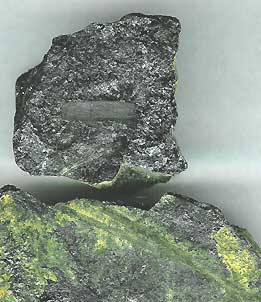Excerpts from Jim Conrad's
Naturalist Newsletter
from the June 22, 2006 Newsletter issued from Polly's Bend, Garrard County, in Kentucky's Bluegrass Region, USA
COAL FOSSILS
Someone must have kept a pile of coal where I decided to place my garden, for when I was digging up the soil there I unearthed many chunks of coal. I put them into a bucket and now when I want a slow fire I burn them.
The smoke from my coal fires stinks, smelling mightily of sulfur. That's to be expected, since it's known that coal mined in nearby eastern Kentucky and in my home area of western Kentucky contains a high sulfur content, and therefore contributes greatly to acid rain if the power plant burning it doesn't employ scrubbers in its smokestacks. Coal mined out west generally possesses a lower sulfur content and thus is preferred by power plants, since it's cheaper to clean.
The other morning while preparing breakfast over my campfire I began cracking open some coal chunks looking for fossils. Since coal is the remains of plants and animals living millions of years ago (ours lived between 323 and 290 million years ago), coal is very fossiliferous. However, during the process of changing from swamp muck to rock typically the fossils have been squeezed and distorted to the point of no longer being recognizable. Still, sometimes you find something.
 At the right you can see two chunks I cracked open. In the center of the top chunk there's a quadrangular item with a narrow band across its middle. I think that that is a section of stem from something like a modern-day horsetail. 300,000,000 years ago spore-producing horsetails were among the most important plants of the coal-producing swamps covering what would become Kentucky.
At the right you can see two chunks I cracked open. In the center of the top chunk there's a quadrangular item with a narrow band across its middle. I think that that is a section of stem from something like a modern-day horsetail. 300,000,000 years ago spore-producing horsetails were among the most important plants of the coal-producing swamps covering what would become Kentucky.
The bottom coal chunk in the photo displays two fossil items looking like blades of grass. I know they're not blades of grass, however, because whatever produced the fossil lived around 300,000,000 years old, while flowering plants didn't arise until around 30,000,000 years ago, and grasses are flowering plants.
Something else the bottom chunk in my picture shows is a yellow crust. That's sulfur. No wonder my coal smoke is so stinky.